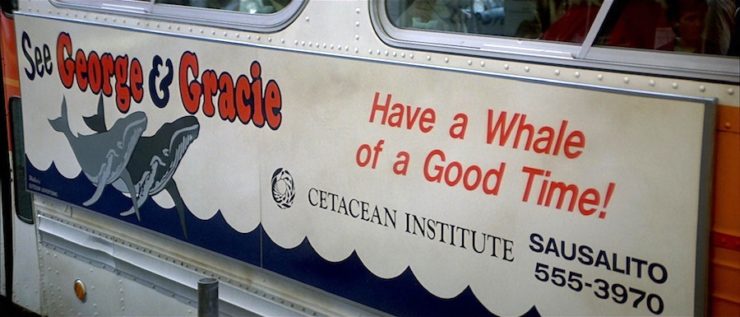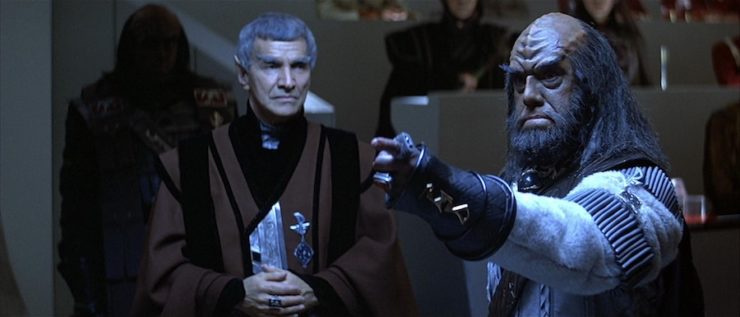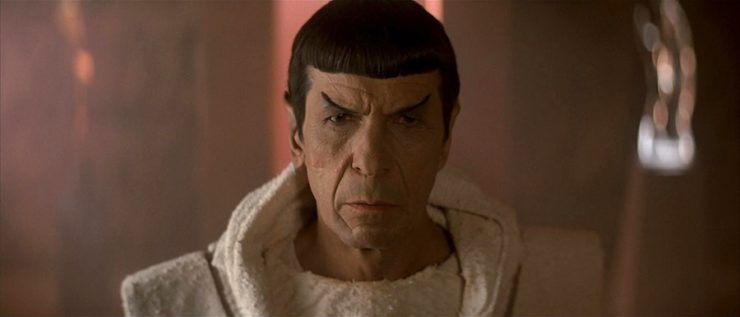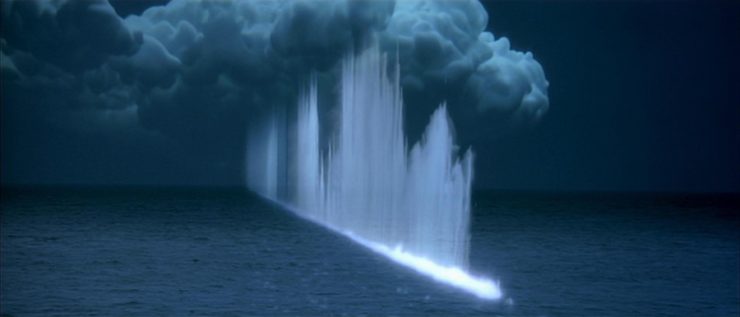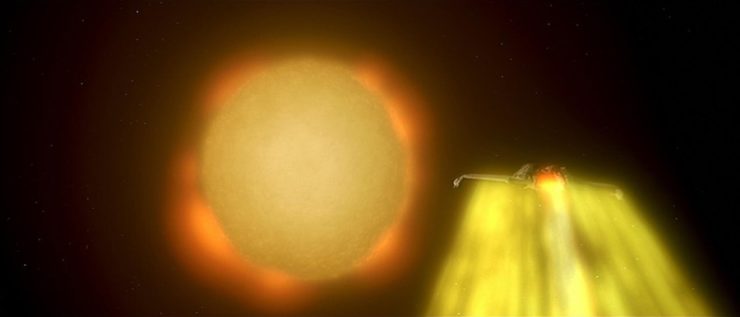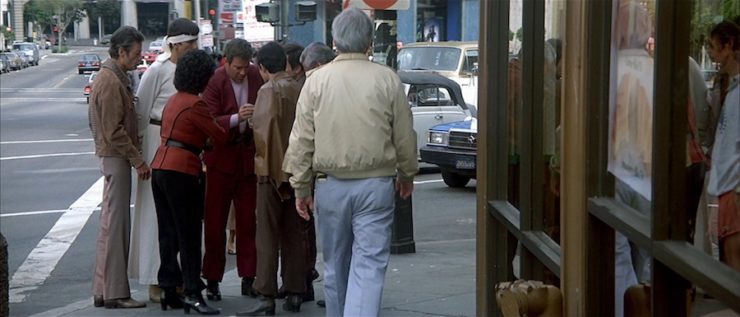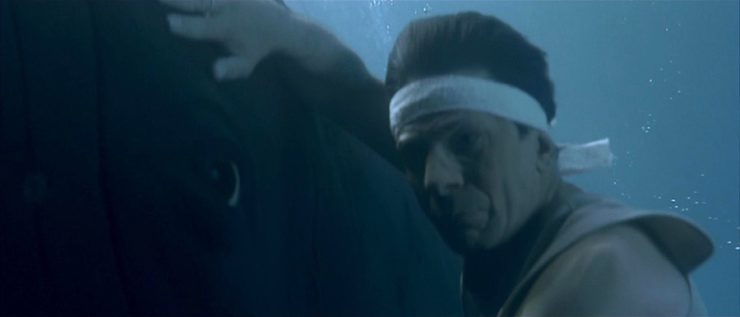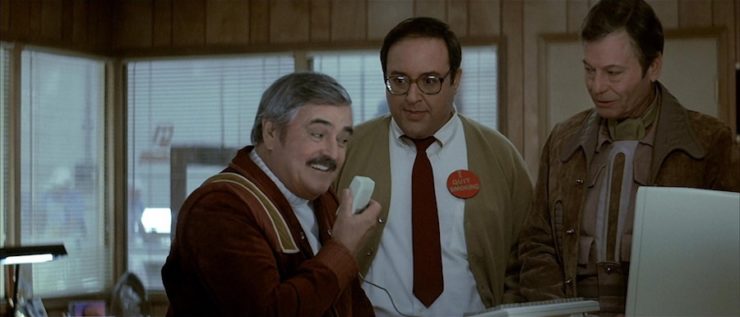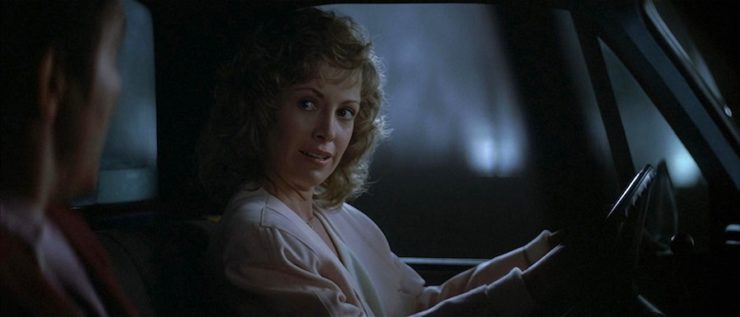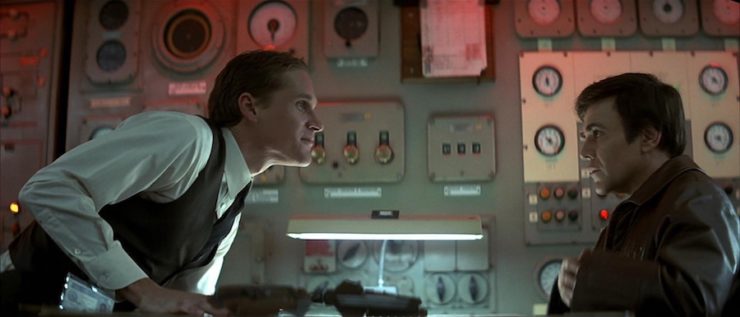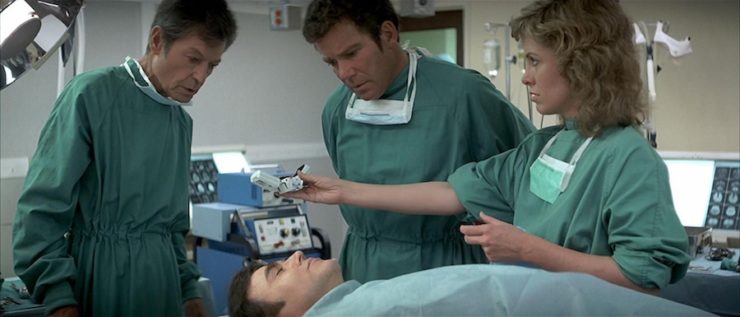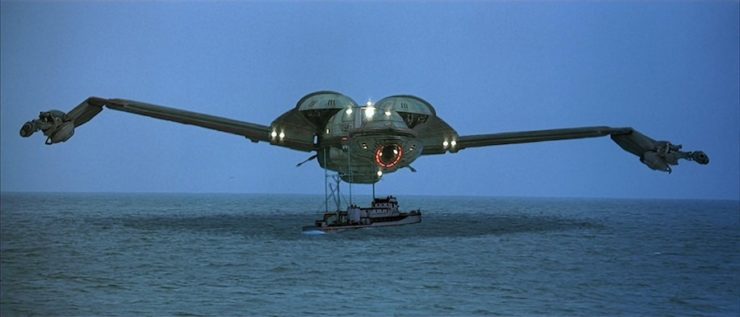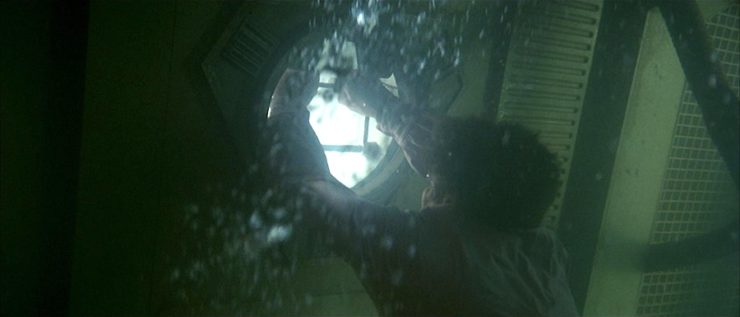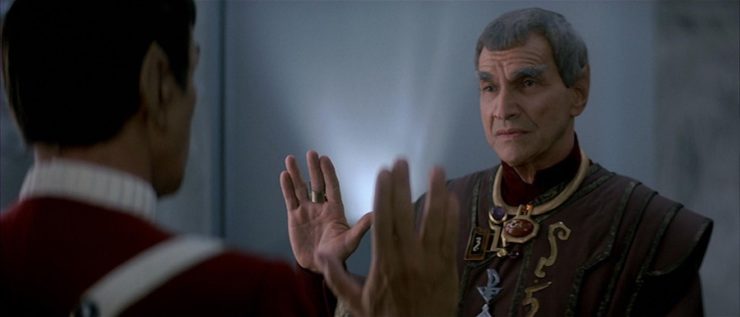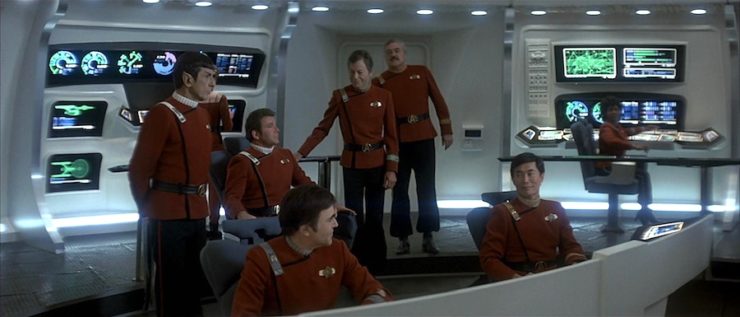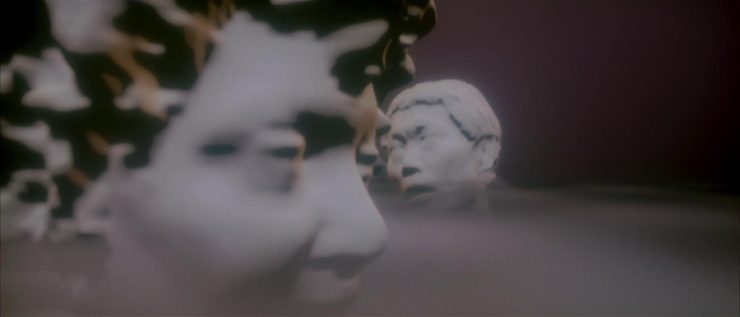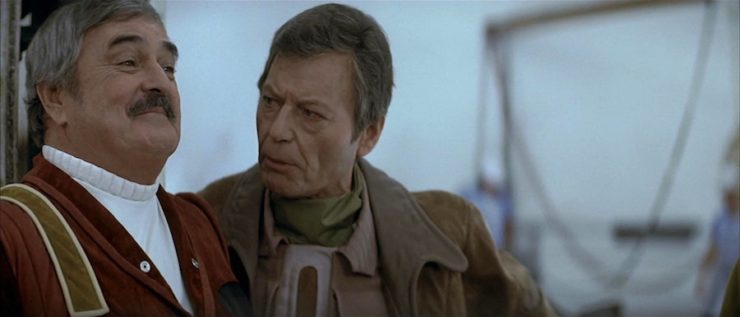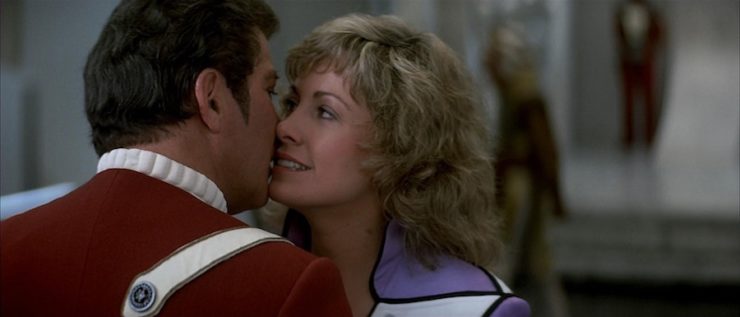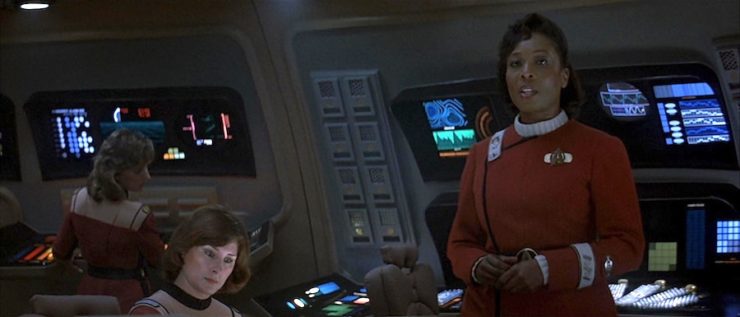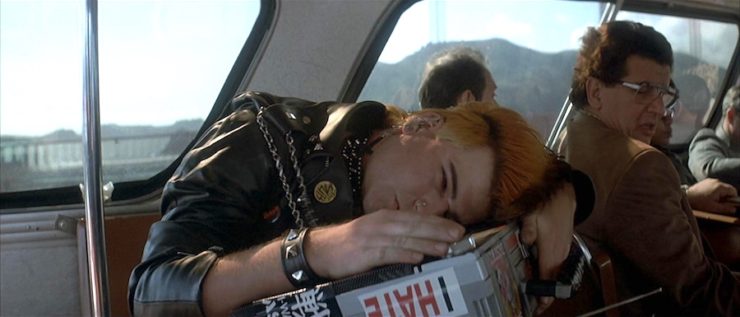Star Trek IV: The Voyage Home
Written by Leonard Nimoy & Harve Bennett and Steve Meerson & Peter Krikes and Nicholas Meyer
Directed by Leonard Nimoy
Release date: November 26, 1986
Stardate: 8390.0
Captain’s log. A giant log flies through space making funky noises. The U.S.S. Saratoga investigates; it appears to be a probe, and it’s also heading directly toward Earth.
On Earth, the Klingon ambassador demands that Kirk be extradited to the Klingon Empire for several crimes, including the theft of Kruge’s ship, the death of Kruge and his crew, and his involvement in Genesis, which the ambassador describes as a doomsday weapon Kirk developed via his son (no mention of Carol Marcus) to be used against the Klingons.
Sarek shows up and counterargues, and then the Federation President announces that Kirk has been charged with nine counts of violations of Starfleet regulations. The Klingon ambassador is outraged, and declares, “There shall be no peace as long as Kirk lives!” before stomping out in a huff.
On Vulcan, McCoy has painted “HMS BOUNTY” on the side of Kruge’s ship. It’s been three months since the last movie, and Spock has spent his time re-training his brain meats. At one point, he answers a barrage of questions, some verbally, some by typing them in. Spock’s mother Amanda has programmed an extra question into the mix: “how do you feel?” Spock finds the question to be a silly goose, no matter how Amanda tries to explain it to him.
The Saratoga is hit with a communication from the probe, which burns out all its systems, leaving the ship adrift. And it’s not the only one: two Klingon ships, and several other Starfleet vessels have also been neutralized by the probe. And it continues to head straight for Earth.
On Vulcan, the crew gets the Bounty ready for departure. Everyone’s wearing the same outfit they had on three months ago when they landed on Vulcan (an entire planet full of logical beings, and nobody has a change of clothes?????). Kirk says his goodbyes to Saavik—who, for reasons nobody bothers to explain, isn’t coming along—and his hellos to Spock, who takes the science station. Saavik says she hasn’t had the opportunity to tell Kirk how David died, which makes you wonder what they’ve been doing for the past three months that that opportunity didn’t present itself.
The probe arrives at Earth, killing power to Spacedock and directing its communications at Earth’s oceans. This causes tremendous upheaval, including tsunamis and storms.
As the Bounty approaches Earth, Chekov reports no ships on assigned patrols, and Uhura’s having trouble deciphering the comm traffic. However one thing gets through: a planetary distress call from the president, warning everyone not to approach Earth. The probe has ionized the atmosphere, wiped out power systems, and is burning the oceans.
After the crew takes a minute to be gobsmacked, Kirk has Uhura put the probe’s signal on the speakers. Spock points out that the signal is directed at Earth’s oceans, and Kirk has Uhura modify the signal to what it would sound like underwater. Spock recognizes the sound, and confirms it in the Federation database that was downloaded into the Bounty‘s computer: it’s the song of the humpback whale. Unfortunately, there are no humpback whales, having been hunted to extinction in the 21st century. They can simulate whalesong, but they don’t know the language, so they can only provide gibberish. The only solution Spock can see is to find humpback whales—which only exist on Earth of the past.
So they go back in time. Because of course they do.
Using Spock’s computations, Sulu flies the ship around the sun and through time, winding up in 1986. Chekov engages the cloak and Uhura picks up whalesong—in San Francisco, oddly. However, they have a bigger problem: the dilithium crystals are destabilizing. However, Spock has a theory that they could recrystallize the dilithium using the high-energy photons from a nuclear reactor.
Sulu lands in Golden Gate Park (scaring the crap out of two garbage collectors). Since they’re using money in this time period, Kirk sells the antique glasses McCoy gave him in The Wrath of Khan, getting a hundred bucks for them, which he divvies up among the group.
Kirk and Spock track down the whales, Uhura and Chekov are tasked with collecting the photons needed to fix the ship, while Sulu, Scotty, and McCoy get to figure out how to construct a tank in the cargo bay of the Bounty to hold the whales.
After Kirk sees an ad for the humpback whales George and Gracie at the Cetacean Institute in Sausalito, he and Spock hop on a bus, Gus, and head to Sausalito. They get a tour from Dr. Gillian Taylor of the institute, who talks about the slaughter of whales, before introducing their “pride and joy,” George and Gracie, a pair of humpback whales who wandered into the institute as calves.
Kirk sees this as a godsend, as they can beam them up together from the tank. But they have a ticking clock, as the plan is to release the pair of them (George and Gracie, not Kirk and Spock) into the wild. And then they get released into the wild, too, as Taylor tosses them out of the institute because Spock dives into the tank and mind-melds with the whales.
Spock wanted to make sure they had the whales’ consent before they just yanked them onto a space ship. He seems to think that he has it, and says so to Kirk as they walk back to San Francisco.
Taylor talks with her boss, and says that the decision to let George and Gracie out is tearing her up. She doesn’t want to lose them, but they’ll die in captivity, plus the institute can’t afford to keep them. She drives home, and sees Kirk and Spock walking along the bay. Against her better judgment, she offers them a lift. Also against her better judgment, she agrees to dinner with them—though Spock winds up declining—mostly because Spock somehow knows that Gracie is pregnant. That information hasn’t been released to the public.
Uhura and Chekov track down a nuclear submarine to Alameda, though directions to Alameda prove difficult to come by. Eventually they find their way there, and one of the ships in dock in the yard is the Enterprise. Yay symbolism! Their plan is to beam in at night, snag the photons, and beam out with no one the wiser.
Scotty and McCoy go to Plexicorp, where the former poses as a visiting professor from Edinburgh who is outraged that there’s no record of his scheduled tour of the facility. Dr. Nichols, however, is more than happy to provide that tour. At the end, Scotty offers him the formula for transparent aluminum in exchange for enough Plexiglas to construct the tank they need (since that will cost more than the thirty bucks Kirk gave them). Sulu, meanwhile, makes friends with a helicopter pilot.
Taylor and Kirk have pizza and beer. Kirk takes a shot at convincing Taylor that he can save the whales. He goes ahead and tells her the truth—well, he leaves out the part about the probe destroying Earth, just saying that they want to repopulate the species in the 23rd century—but when she informs him that they’re being shipped out at noon the next day, Kirk ends dinner early. Before they go their separate ways in Golden Gate Park, Kirk says that he has to take two whales to the 23rd century. He can go out to the open sea to get them, but he’d rather have George and Gracie. Taylor is now completely convinced that he’s nuts.
Uhura and Chekov beam onto Enterprise and collect the photons Scotty needs to recrystallize. Unfortunately, the carrier crew tracks the power drain. Scotty is only able to beam one at a time, so Uhura goes first with the collector, but the radiation interferes with the signal and Scotty can’t get a lock before Chekov is captured. He’s interrogated, to very little effect, and then he makes a break for it. Unfortunately, he’s injured in the escape attempt and is brought to a nearby hospital.
Scotty has finished prepping the cargo bay for the tank, and now is working on the recrystallization. Uhura is scanning the radio waves for any news on Chekov.
In the morning, Taylor shows up for work to find that the whales are already gone. Her boss sent them out quietly the previous night to avoid a media mob scene. Taylor is furious that she didn’t get to say goodbye, and storms out, heading straight for Golden Gate Park, just as Sulu is flying the tank into the Bounty with the helicopter. Taylor screams out Kirk’s name and crashes into the cloaked ship. Kirk beams her up and she’s rather stunned to realize that everything he said was true—and more, as she sees Spock without the headband hiding his ears and eyebrows.
Uhura has finally found Chekov, in Mercy Hospital, going for emergency surgery. He’s listed as critical and not expected to live.
Kirk, Taylor, and McCoy infiltrate the hospital (they’re all wearing scrubs) and find Chekov—McCoy bitching and moaning about 20th-century medicine the entire time—in a secure ward. They manage to bully their way in and then lock the surgical staff in a closet so McCoy can cure Chekov without drilling holes into his head. They wheel him out of the room and get chased by security before beaming out while in an elevator out of sight.
Taylor bullies her way onto the ship—she has no family and they need her help to acclimatize the whales to the future—and they take off. Uhura tracks the radio transmitters on George and Gracie and they arrive just as the pair are being pursued by a whaling ship. Sulu manages to maneuver the Bounty between the harpoon and the whales, and then Kirk orders the ship decloaked. Scared shitless, the whalers bugger off, and Scotty beams George, Gracie, and the water around them onto the ship.
They head out into space and do the time-warp again (it’s just a jump to the left!), arriving right after they left the 23rd century.
Unfortunately, in order to deliver the whales, they have to land on Earth, and that puts them in the probe’s path. Main power is shot to hell, and the Bounty crash-lands near the Golden Gate Bridge. The release for the tank is underwater, so Kirk orders everyone to abandon ship while he manfully swims down to release the whales. (It’s fun watching Shatner’s weave go wobbly as he swims, too…..)
George and Gracie respond to the probe, they have a nice talk, and then the probe buggers off. The Earth is saved.
However, now that that’s taken care of, there’s the matter of the charges against Kirk and the others. They stand before the president and the council, accused of conspiracy, assault on Federation officers, theft of the Enterprise, sabotage of the Excelsior, destruction of the Enterprise, and disobeying Starfleet orders. Kirk pleads guilty, but then the president announces that all charges are dismissed save one, thanks to the mitigating circumstances of the crew saving the planet. The one charge that sticks is disobeying orders, which is only on Kirk. His sentence is to be demoted to captain and to be put back in charge of a starship. Gawrsh.
Taylor takes her leave of Kirk—she’s off to a science vessel to catch up on three hundred years—and Sarek also takes his leave of Spock. Spock gives him a message for Amanda: “I feel fine.”
The seven of them take a shuttle through Spacedock to their new assignment. Because even though three of them are captains, and the other four are commanders (and of those four, one is ready for command and the other was until very recently a first officer of a starship), they’re all being assigned to the same ship in the same positions they were in two (or more) rank grades ago. Because that totally makes sense. (It makes no kind of sense.)
McCoy is expecting them to get a freighter. Sulu is hoping for Excelsior, to Scotty’s disgust. Instead, they get a Constitution-class ship that has the designation NCC-1701-A: the U.S.S. Enterprise.
On the bridge of their new ship, Kirk tells Sulu, “Let’s see what she’s got,” and off they go into the wild black yonder.
Can’t we just reverse the polarity? Apparently travel back in time makes you see images that look like busts of your friend’s heads that grow up out of the ooze. Or something.
Fascinating. At the end of the movie, Sarek mentions that he disapproved of Spock’s entry into Starfleet, and now—decades later—he admits that he might have been mistaken in that disapproval. Real fucking generous there, Dad.
I’m a doctor not an escalator. McCoy is beside himself at Mercy Hospital, snarking off at every medical professional he meets, and also giving a patient on dialysis a pill that grows her a new kidney.
Ahead warp one, aye. A scene was written and attempted to be filmed where Sulu meets a young boy who turns out to be an ancestor of his. However, the child who was hired for the role was having trouble performing the scene, and it had to be scrapped.
The film establishes that Sulu was born in San Francisco.
Hailing frequencies open. While Uhura has no standout scenes like she did last time, she is quietly superbly competent throughout the film, playing the probe’s communication as it would sound underwater, tracing the whalesong in 1986, finding out what happened to Chekov, and tracking the whales once they’ve been released.
I cannot change the laws of physics! Scotty has a grand old time playing the blustery professor at Plexicorp, to the point where McCoy cautions him not to bury himself in the part.
It’s a Russian invention. Chekov does a lovely job of stonewalling his interrogator aboard the Enterprise when he’s captured, and then almost manages to escape, done in by a fall from a great height. After McCoy repairs the damage to his noggin, Kirk asks him for name and as he’s coming out of it, and he says, “Chekov, Pavel. Rank: admiral,” that last word said with a goofy smile.
Go put on a red shirt. While it’s likely that some people on Earth died when the probe started kicking up the oceans, there are absolutely no on-screen deaths in this movie. Indeed, only once is a weapon actually fired, when Kirk uses a phaser to zap the door locking the surgical team in the closet while McCoy works on Chekov. (Chekov threatens his captors with his phaser, but the radiation from the Enterprise‘s nuclear reactor makes it futz out, so it won’t fire.)
No sex, please, we’re Starfleet. Kirk’s tropism for brainy blondes continues unabated, as he flirts outrageously with Taylor, and it actually works. That he’s there to save Taylor’s beloved whales from extinction certainly doesn’t hurt…
Channel open. “Cloaking device now available on all flight modes.”
“I’m impressed. That’s a lot of work for a short voyage.”
“We are in an enemy vessel, sir. I did not wish to be shot down on the way to our own funeral.”
Chekov being efficient, Kirk being impressed, and Chekov showing a knack for fatalism and humor all at the same time.
Welcome aboard. Back from the previous film are both Mark Lenard as Sarek and Robin Curtis as Saavik, the latter very briefly and left on Vulcan for no reason the script can be arsed to explain. Sarek will next be in The Final Frontier played by Jonathan Simpson, with Lenard reprising the role in The Undiscovered Country and TNG‘s “Sarek” and “Unification I.” Ben Cross will play the role in the 2009 Star Trek, with James Frain set to play him in Discovery.
Jane Wyatt reprises her role as Amanda from “Journey to Babel“; a younger version of the character was seen in “Yesteryear,” voiced by Majel Barrett, and younger versions will be seen again in The Final Frontier and the 2009 Star Trek, played by Cynthia Blaise and Winona Ryder, respectively.
Majel Barrett returns as Chapel, last seen in The Motion Picture. This is Chapel’s final onscreen appearance, though Barrett will continue to provide the voice of Starfleet computers, and also play Lwaxana Troi on TNG and DS9, starting in “Haven.” Grace Lee Whitney returns as Rand; she’ll be back in The Undiscovered Country and Voyager‘s “Flashback” as a member of Sulu’s Excelsior crew. Both Chapel and Rand are working at Starfleet Headquarters.
Madge Sinclair plays the Saratoga captain, significant in that she is the first female ship captain seen in Trek history, finally putting the lie to Janice Lester’s comment. And she’s a woman of color, too! Sinclair will return to Trek in TNG‘s “Interface” as another starship captain, Silva La Forge.
Catherine Hicks debuts the role of Taylor. Brock Peters plays Cartwright; he’ll be back in The Undiscovered Country, and also have the recurring role of Joseph Sisko on DS9, starting in “Homefront.” Robert Ellenstein plays the Federation President, the first person to be seen playing the occupier of that office; the actor will also appear in “Haven” as Troi’s almost-father-in-law. John Schuck plays the Klingon ambassador; the character is next seen in The Undiscovered Country, while the actor will also return as a Cardassian legate in DS9‘s “The Maquis Part 2,” a member of the chorus in Voyager‘s “Muse,” and Antaak in Enterprise‘s “Affliction” and “Divergence.” And two of the Marines on the Enterprise were played by actual Marines assigned to the Ranger (the ship they filmed on): 1st Sgt. Joseph Naradzay and 1st Lt. Donald W. Zautcke.
We get a Robert Knepper moment, as Alex Henteloff plays Nichols. He had the recurring role of ambulance-chasing lawyer Arnold Ripner on Barney Miller, one of your humble rewatcher’s favorite shows.
And, of course, we have James Doohan, George Takei, Walter Koenig, and Nichelle Nichols, as ever.
Trivial matters: The film is dedicated to the astronauts who were killed when the space shuttle Challenger exploded ten months prior to the movie’s release.
This movie is a sequel to The Search for Spock, picking up three months afterward and dealing with the ramifications of the events of that film.
Originally intended to be released in the summer, just like the other Trek films, it had to be pushed back to accommodate William Shatner’s shooting schedule for T.J. Hooker.
The movie was released in 1986, which was the twentieth anniversary of Star Trek‘s debut. In addition, this was the year in which Paramount announced that the next year would see a new Trek TV show, Star Trek: The Next Generation, which some dork rewatched on this site a few years ago.
The method of time travel used is the same as that employed in both “Tomorrow is Yesterday” (to get home) and “Assignment: Earth.”
Kruge’s Bird-of-Prey is renamed after the HMS Bounty, the 18th-century Royal Navy ship on which the crew famously mutinied against Captain William Bligh.
The early drafts of the script had Taylor as a male UFO nut, and Eddie Murphy was considered for the role. He decided to do The Golden Child instead (not one of his brightest career moves, though probably a good one for the Trek franchise, all things considered), and Taylor was rewritten as a woman.
The Klingon ambassador was given the name Kamarag in Vonda N. McIntyre’s novelization. The character will return in The Undiscovered Country, and also be seen in the novels Sarek by A.C. Crispin, several issues of DC’s second run of monthly Star Trek comics by Peter David, James W. Fry III, & Arne Starr, and your humble rewatcher’s novella The Unhappy Ones in Seven Deadly Sins.
McIntyre’s novelization also included the scene with Sulu’s ancestor, includes Kirk and McCoy discussing the events of “The City on the Edge of Forever” when the notion of time travel first comes up, gives the garbage collectors who saw the Bounty land a subplot for some strange reason, and establishes that Nichols really did invent transparent aluminum, thanks to this helping hand from Scotty, and that Scotty has, in fact, heard of him for this reason which, if nothing else, keeps Scotty and McCoy from being irresponsible assholes.
The Federation President was named Hiram Roth in your humble rewatcher’s Articles of the Federation and Alistair Fergus in the Star Trek IV Sourcebook Update of FASA’s role-playing game. In the former novel, I established that Roth died in office during the reconstruction of Earth following this movie.
This is Taylor’s only onscreen appearance, but she is seen in the graphic novel Debt of Honor by Chris Claremont, Adam Hughes, & Karl Story, the short stories “Whales Weep Not” by Juanita Nolte (Strange New Worlds VI), “Scotty’s Song” by Michael Jasper (Strange New Worlds IV), and “The Hero of My Own Life” by Peg Robinson (Strange New Worlds II), and the reference book Federation: The First 150 Years by David A. Goodman.
The Saratoga captain is given the name of Margaret Alexander in McIntyre’s novelization, and she later appears with her family name changed to Sinclair-Alexander after marrying. She shows up in the Crucible trilogy and Serpents Among the Ruins, all by David R. George III, Forged in Fire by Andy Mangels & Michael A. Martin, and Cast No Shadow by James Swallow.
Early drafts of the script had Saavik remaining behind on Vulcan because she was pregnant with Spock’s child after their little pon farr experience on the Genesis planet. With that dropped, there’s no reason given why Saavik doesn’t go with the Bounty to Earth. This winds up being Saavik’s last onscreen appearance as well, though the early drafts of The Undiscovered Country had Saavik in the role that eventually wound up with Valeris. The character has continued to be seen in tie-in fiction, such as the novels The Pandora Principle by Carolyn Clowes (which gave her origin), Dwellers in the Crucible and The Unspoken Truth by Margaret Wander Bonanno, and Vulcan’s Forge, Vulcan’s Heart, and the Vulcan’s Soul trilogy all by Josepha Sherman & Susan Shwartz (in which Spock and Saavik are married in the early 24th century), the Mere Anarchy novella The Blood-Dimmed Tide by Howard Weinstein, the short stories “Infinity” by Susan Wright (The Lives of Dax), “Just Another Little Training Cruise” by A.C. Crispin (Enterprise Logs), “Prodigal Father” by Robert J. Mendenhall (Strange New Worlds II), and “The First Law of Metaphysics” by Michael S. Poteet (Strange New Worlds II), as well as more comic books than I can possibly list here.
Michael Okuda was hired to create the computer displays for this film, beginning a relationship with Star Trek that would continue for decades, as Okuda would continue to be the go-to guy for computer displays (among many other things, including co-authoring The Star Trek Encyclopedia with his wife Denise Okuda).
While Chekov and Uhura were on the aircraft carrier Enterprise, those scenes were actually shot on the Ranger, which was in dock. The Enterprise was at sea, and also on active duty, so they wouldn’t have been allowed to film on it in any case.
In Greg Cox’s The Eugenics Wars: The Rise and Fall of Khan Noonien Singh, Roberta Lincoln, the partner of Gary Seven from “Assignment: Earth,” infiltrates Area 51 and retrieves Chekov’s phaser and tricorder so 20th-century Earth won’t get their hands on 23rd-century technology. Earlier in that same duology, Lincoln briefly meets Taylor at a conference.
The novel Probe, nominally written by Margaret Wander Bonanno (the whole sordid story is on Bonanno’s web site), is a sequel to this film, which explores the origins of the probe.
Novelist and writer of “The Pirates of Orion” Howard Weinstein served as a story consultant of sorts in the early development of the film, and he is one of the ones who turned Bennett and Nimoy on to the notion of having the crew save humpback whales from extinction. Weinstein is given a thank-you credit in the film, and he used those talks as a jumping-off point for his novel Deep Domain.
To boldly go. “Everybody remember where we parked!” This is a fun little movie, probably the most genuinely enjoyable of a bad lot—and by “bad lot,” I mean “Star Trek movies,” as I maintain that Trek and movies are a bad fit.
It’s best remembered as the “save the whales” movie, and the overriding message is a very important one, as sledgehammery as the script has it be. Luckily, things are better now than they were thirty years ago, as humpback whales went from being classified as endangered in 1986 to being upgraded to vulnerable in 1996 and least concern in 2008. The movie’s prediction of a 21st-century extinction for the species is looking less likely. I, for one, am grateful to see that Trek‘s track record for predicting the immediate future remains dreadful (viz. the lack of any Eugenics Wars in the 1990s), as I really don’t want to live to see World War III and the post-atomic horror, thank you very much.
And the dialogue in this movie simply crackles. Just as with The Search for Spock one suspects Harve Bennett’s influence (one of four credited scriptwriters), as the conversational humor is just as strong in this one as it was in the last film, this time aided by a more lighthearted storyline (the stakes are high, and there’s plenty of social commentary, but the basic story is the, ahem, fish-out-of-water story of the crew in the 20th century). McCoy’s snark, Kirk and Spock’s banter both with each other and with Taylor, Scotty’s bluster with Nichols, Sarek and the Klingon ambassador trading insults, and so on. “Double dumb-ass on you!” “You look like a cadet review!” “What does it mean,’exact change’?” “I love Italian—and so do you.” “I’m from Iowa, I just work in outer space.” “We’re dealing with medievalism here!” “One little mistake.” “The bureaucratic mentality is the only constant in the universe.” Just a lot of fun.
It’s not without its flaws. Saavik’s remaining on Vulcan is utterly incomprehensible on every possible level. Just a few scenes earlier, Spock told his mother that he had to go to Earth to offer testimony because “I was there.” So was Saavik, so shouldn’t she be offering testimony, too, as the only survivor of the Grissom? (Of course, the characters can’t actually say, “Sorry, Saavik, you could come with us, but nobody liked you as much as the person who played the role before you, and you were created to replace Spock who we wound up bringing back instead, so as we say on Earth, c’est la vie.”)
Scotty’s cavalier granting of the invention of transparent aluminum to some schlub he needs Plexiglas from is spectacularly irresponsible, and in a franchise that has generally done a good job of stressing the need to not muck with history (Christopher’s son’s importance in “Tomorrow is Yesterday,” Edith Keeler’s tragic influence in “The City on the Edge of Forever,” the knife’s edge of Gary Seven’s work in “Assignment: Earth,” not to mention future works like First Contact and DS9‘s “Past Tense” two-parter), Scotty’s recklessness is appalling. Worse, it’s played for a cheap laugh.
Plus, how did nobody bump into the invisible spaceship that was in the middle of a big clearing in the most popular public park in the Bay Area? How come Uhura and Chekov have no idea where Alameda is when both of them went to Starfleet Academy, which is headquartered in San Francisco? (This stands out particularly coming after McCoy’s comment that San Francisco hasn’t changed much in three hundred years as they’re flying over it.) Why are three captains and four commanders being assigned to the same ship? (Just in general, the crowbarring of everyone into the same roles they were in fifteen years earlier in their careers is stupid, and will sour every remaining Trek film in this timeline.) Sending George and Gracie out before their scheduled press event makes no sense for the institute, as museums rarely pass up opportunities for publicity. And the climax is very anti, as the endless flight toward the whaling ship is tedious and uninteresting.
To be fair, that last sequence is the only pacing misstep in the film. Leonard Nimoy’s sophomore effort as a feature film director is far more successful, as the performances are looser and less stiff, the visuals are stronger—just in general, Nimoy is far better at framing shots in this one than he was in The Search for Spock.
All in all, a fun outing. Enjoy it, ’cause it’s the last good outing for this crew. (Cue crowds ready to tar and feather me for disliking The Undiscovered Country. Just wait two weeks, and you can beat me up then…)
Warp factor rating: 6
Next week: Star Trek V: The Final Frontier
Keith R.A. DeCandido talked about The Voyage Home once before, in 2011 when Tor.com did a Trek movie marathon.










